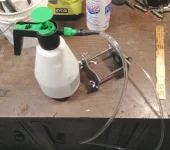I used a professional $300 power bleeder once and then just had to make my own. Small HD garden sprayer and a few odd parts. I was worried that the pump seal might not like DOT3 but it turned out to not be the case.
The RV has 7 brake bleed ports and it is a LOT easier than the old pump and fill and better than a vacuum type.
I just buy a fresh quart of Prestone 3 and pump it all through whenever needed.
This is for the old Dodge single system - very important to maintain.

The RV has 7 brake bleed ports and it is a LOT easier than the old pump and fill and better than a vacuum type.
I just buy a fresh quart of Prestone 3 and pump it all through whenever needed.
This is for the old Dodge single system - very important to maintain.

